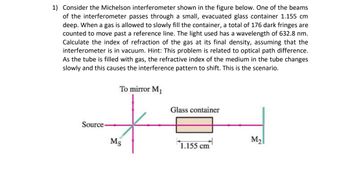Question

Transcribed Image Text:1) Consider the Michelson interferometer shown in the figure below. One of the beams
of the interferometer passes through a small, evacuated glass container 1.155 cm
deep. When a gas is allowed to slowly fill the container, a total of 176 dark fringes are
counted to move past a reference line. The light used has a wavelength of 632.8 nm.
Calculate the index of refraction of the gas at its final density, assuming that the
interferometer is in vacuum. Hint: This problem is related to optical path difference.
As the tube is filled with gas, the refractive index of the medium in the tube changes
slowly and this causes the interference pattern to shift. This is the scenario.
To mirror M₁
Glass container
Source
Ms
M2
1.155 cm
Expert Solution
This question has been solved!
Explore an expertly crafted, step-by-step solution for a thorough understanding of key concepts.
Step by stepSolved in 2 steps

Knowledge Booster
Similar questions
- Light of wavelength 580NM is incident on a slit of width 2.75 × 10^-6 m. The observing screen is placed 2.00 m from the slit. 1) Find the width of central maximum 2) Say two things that would make width of the central maximum smaller?arrow_forwardTwo stars are 3.6 × 10¹1 m apart and are equally distant from the earth. A telescope has an objective lens with a diameter of 1.66 m and just detects these stars as separate objects. Assume that light of wavelength 520 nm is being observed. Also, assume that diffraction effects, rather than atmospheric turbulence, limit the resolving power of the telescope. Find the maximum distance that these stars could be from the earth. Number i Unitsarrow_forwardWavelength (nam) Rr4. ACRY 12921 Visible spectruini 2. A single-slit is illuminated by violet light of wavelength 405 nm. The width of the slit is 1.25 mm. The slit-to-screen distance is 4.50 m. Calculate the distance between the third diffraction minima (m3) and the first diffraction minima (m = 1) on the same side of the central diffraction maximum.arrow_forward
- MY NOTES ASK YOUR TEACHER PRACTICE ANOTHER A 2000 Hz sound wave passes through a wall with two narrow openings 30 cm apart. If sound travels on average 355 m/s, find the following. (a) What is the angle of the first order maximum? 36.27 (b) Find the slit separation when you replace the sound wave with a 2.30 cm microwave, and the angle of the first order maximum remains unchanged. 3.8878 How do you find the angle of a diffraction pattern, given wavelength? m (c) If the slit separation is 1.00 µm, what frequency of light gives the same first order maximum angle? 6.0007e-8X How do you find the angle of a diffraction pattern, given wavelength? Hz Additional Materials O Readingarrow_forwardProblem 5: Light of wavelength λ = 450 nm passes through a single slit of width a = 0.32 mm. A diffraction pattern is formed on a screen L = 1.2 m away. Part (a) Express the relative intensity, I/Imax, of the light at an angle θ in terms of θ, a and λ. Part (b) Calculate the value of I/Imax at an angle of θ = 28°.arrow_forward1) A screen that is 1.0m wide is 2.0m away from a pair of slits illuminated by 633-nmlight, with the screen centered between the slits. Find the highest-order brightfringe that will appear on the screen if the slit spacing is (a) 0.10mm and (b)10µm.arrow_forward
- 3. A particular diffraction grating has 1 300 grooves per millimeter, and 15.0 mm of illuminated area. a) Assuming an incident angle of 45.0°, calculate the diffraction angle for first-order light at 625 nm. b) What wavelength of light would give this same diffraction angle in the second order? )What is the first-order resolving power of the grating? d) What must be the separation (in nm) of two first-order spectral lines centered at 625 nm if they are to be resolved? e) What is the angular dispersion (in degrees) between the two lines in part (d) asthey emerge from the grating?arrow_forwardQuestion 3: Plane waves of light of wavelength 610 nm are incident on a single slit of width 75 μm. A lens focuses the plane waves on a screen 120 cm away (Fig. 2). (a) What is the width of the central maximum on the screen? (b) What is the intensity ratio between the central maximum and the first-order maximum? Light 120 cm Copyright © 2005 Pearson Prentice Hall, Inc. Figure 2arrow_forward3. In a double slit experiment, the distance between the slits is d=1 mm. A screen is situated at a distance of 2.5 m from the slits. Point P is at a distance of 25 cm from O', as in Figure. O' is the orthogonal projection of the center between the slits (0) on the screen. Monochromatic light with frequency v= 550 THz is used in this experiment. (a) Calculate the intensity of light at point P. (b) Calculate the angle ZP00'. (c) Calculate the location of the first three maxima with respect to point O'. (d) Calculate the location of the first three minima with respect to point O'. BONUS: You now consider that each slit has width a =0.05 mm. Calculate the intensity of light at point P. P.arrow_forward
arrow_back_ios
arrow_forward_ios